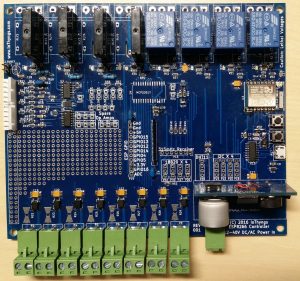Description
ESPEveryThyng
885 Board
Executive Summary
The 885 is an all-purpose feature-rich data acquisition and control board with onboard power conditioning, data processing, and wifi connectivity. Measuring 6.00” x 5.00”, it has provisions for eight relay outputs, eight digital inputs, and five analog inputs complete with signal scaling and filtering. The 885 also has generous expansion capability and provisions for 315mHz key-fob receiver.
Available as a complete assembly, a kit, or the board only, the 885 is a powerful platform for those wanting to monitor and control a lot of channels.
Technical Discussion
Onboard Processor
The 885 has an ESP8266 chip running IoThyngs’ proprietary firmware, although customers are free to reflash with the firmware of their choice. Communication to the ESP8266 is normally via 2.4 GHz WiFi, although it can also be accessed thru a micro USB connection for firmware updates or serial line monitoring.
The ESPEverything 885 is compatible with the following firmware:
- Arduino IDE
- ESPEasy
- ESP Lua
- ESP8266 Basic
- ESP8266 AT command set
- And More
Two different versions of the ESP8266 are compatible with the board: The ESP8266-07 and ESP8266-12.
Using the -12 provides access to 4096 KB of memory.
Using the -07 provides access to 1024 KB of memory which is sufficient for most applications. The WiFi antenna is suitable for most WiFi networks, however a u.FL connector is available on the -07 which permits the use of an external antenna in case of poor signal coverage.
All normal I/O is handled via the I²C bus, however thru holes are provided granting direct access to the GPIO pins.
Analog Inputs
The board provides access to the internal 10 bit ADC on the ESP8266 and in addition provides an ADS1115, 4 channel 16 bit ADC chip.
A 10-pin header provides access to the five analog inputs. All inputs run thru an LMV324 Quad Op Amp and have provisions for scaling resistors, gain resistors and a simple low-pass filter. Various voltage divider resistors are provided to permit a wide range of signal input levels. Scaling resistors and RC filter resistors and capacitors are chosen for unity gain and a 100 Hz cutoff frequency, although these can be changed at the customer’s request.
The Analog inputs can easily be setup for 0-5V, 0-10V, 0-3.3V and 4-20ma signals.
An LM336Z25 precision voltage regulator provides 2.50 VDC reference to the LMV324.
Channel 1 goes from the signal conditioner section straight into the ESP8266 10 bit on-board ADC, so the scaling must be selected to 1VDC Max. Channels 2 thru 5 are directed to an ADS1115 16-bit A/D converter, which communicates to the ESP8266 via the I²C bus. These channels should be scaled to provide 5VDC Max.
Digital Inputs
Eight PCB 2-wire screw terminals provide access to eight digital inputs. Each input is protected by a LTV354T Opto Isolator, which accepts input signals ranging from 3.3 volts to 220 volts, both AC and DC, and further means it’s impossible to wire an input backwards.
All eight digital inputs are routed to a MCP23017 I²C port expander.
Relay Outputs
Eight PCB 3-wire screw terminals provide access to eight relays. Each relay location can be populated with either a G3MB-202P solid state relay or an SRD-5VDC-SL-C mechanical relay. Alternatively, through the addition of two jumpers, one could omit the on-board relays and instead connect discrete relays to the relay control points. This would allow control of large relays or contactors.
Each relay location has an LED to indicate when the relay is energized.
Temperature/Humidity
There are thru holes to directly solder a DHT11 or DHT22 Temperature and Humidity sensor or attach one remotely with wires. There are also four sets of thru holes to wire in remote DS18B20 1-wire digital temperature sensors. In addition there are four I2C expansion ports.
Power Module
A Power Module PCBA is soldered directly to the 885. This module accepts up to 40 volts, both AC and DC, and outputs 5 VDC and 3.3 VDC up to 2 amps. Since the input is bridge rectified, it’s impossible to wire the input voltage backwards. This also allows the board to be powered by inexpensive AC transformers used to power irrigation valves or low voltage lighting. Minimum input is 9 volts.
315 mHz Receiver Module
A header is provided to install an optional 315 mHz radio receiver module. This allows a remote control radio key-fob to activate up to 4 GPIO. This is useful to implement gate controllers, garage door controllers, timer overrides for irrigation systems, manual operation of pool lights, grounds lighting etc.
Prototyping Area
An on-board prototyping area is provided with a roughly rectangular 10 x 22 array of thru-hole soldering pads. There is also a 2 x 20 pattern at the edge of the array that coincides with the edge of the board so that one could attach a 2-row header or connectors. Pads are provided to access three unused Op-amps to simplify any analog prototype design. The prototyping area is in close proximity to the GPIO access header and pads are provided for +5V, +3.3V, +2.5V Vref and Gnd as well as the analog outputs for the five analog channels.
Other features
- Test points are provided at each analog signal between the S/C and A/D as well as +5V, 2.5VREF, +3.3V, and GND at the LM336Z25 precision voltage regulator.
- Four available I²C connection points to connect other I²C devices
- Access to three unused Op Amp channels (can be put to use along with Prototyping Area circuits)




Reviews
There are no reviews yet.